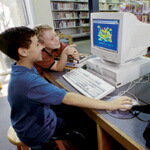
In a magical online city called Whyville, children ages 8 to 14 meet to interact and have fun learning. These young Whyvillians explore science, economics and citizenship. They debate in the Whyville Senate, fly hot-air balloons to learn vector arithmetic, write articles for The Whyville Times,, and investigate the spread of the infectious Why-Pox. Now, in consultation with nutrition experts at the Health Science Center, the creators of Whyville have expanded the city to address the international epidemic of poor nutrition in the 8-14 age group.
The Whyville Grill is open and ready for business. So is the Whyville Market.
Whyvillians come to the grill, the market, and, very soon, the Whyville Cafeteria sponsored by the School Nutrition Board, all located in the Whyville Mall Food Court, to purchase and eat their virtual food. William Beer, M.D., clinical assistant professor at the Health Science Center and a clinical nutritionist at the South Texas Veterans Health Care System says: “One of the most exciting things is the Menu Planner, which includes 500 of the most common food choices. The children can see Nutrition Facts, such as carbohydrates and fiber, on all the food. We want children to focus on nutrition value.”
One in five children in the U.S. is overweight, and these children are at elevated risk for diabetes and heart disease, according to the National Institutes of Health. Thirty-five percent of children are at risk to develop type 2 diabetes later in life, according to the Institute of Medicine of the National Academy of Sciences.
“We’re giving the children the problem, and they are then left to find their own individual solutions,” Dr. Beer said. “This is important, because nutrition in the real world is a complex challenge, and we know that only 20 percent of children in the United States eat a healthy diet in their real lives. As in the real world, in Whyville they have lots of options. Unlike the real world, however, they can readily see the consequences of their nutrition decisions.”
Each new Whyville citizen is asked to create an avatar-based persona that allows participation in activities. Health or lack thereof will manifest itself graphically on the avatar. Intake of too few calories may lead to a pale appearance, while long-term deficiency in vitamin C may lead to a case of scurvy, resulting in ugly red sores. Well-nourished citizens, in contrast, will look better, move faster, and earn a health bonus in clams.
Faculty from the Health Science Center’s Medical School, Dental School, School of Nursing, Graduate School of Biomedical Sciences and School of Allied Health Sciences guided the development of the nutrition area of Whyville. James Bower, Ph.D., professor at the Health Science Center’s Research Imaging Center and at UT San Antonio, was one of the driving forces that led to the debut of Whyville in 1999.
The Whyville Web site, http://www.whyville.net, is created, produced and maintained by Numedeon Inc. of Pasadena, Calif. With 1.5 million registered users, Whyville is one of the largest educational sites for children on the World Wide Web.

